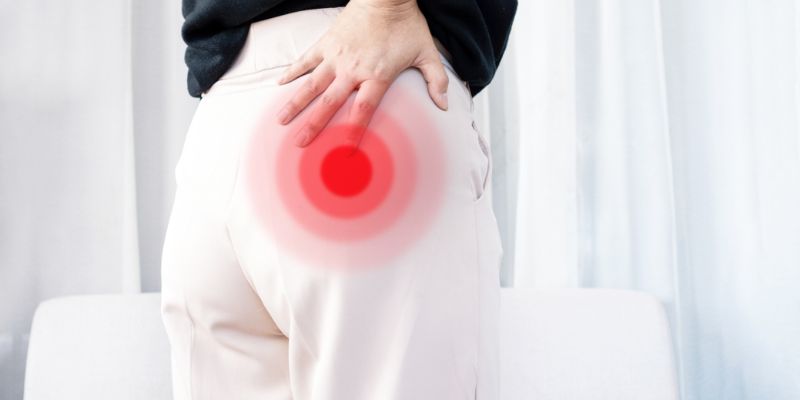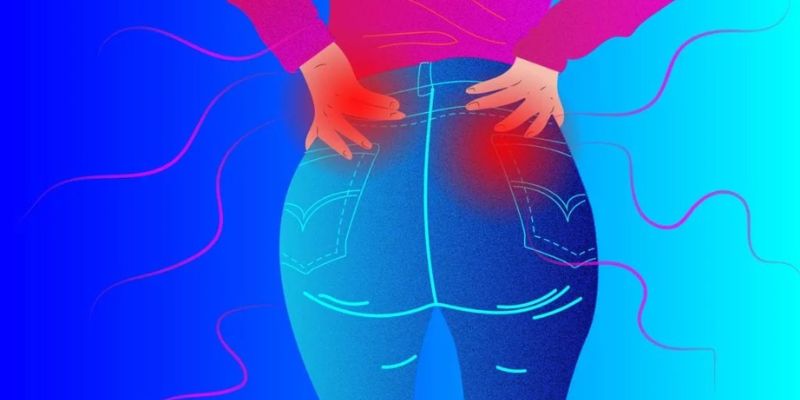Do you suffer from pain in your buttocks? You're not alone. Lower back and buttock pain almost always accompany one another — pain radiates to the gluteal muscles whenever the lower back is injured. Thankfully, these cases are nothing serious and can be easily treated with at-home measures or non-invasive techniques like heat and physical therapy exercises.
To help you better understand your buttock pain condition and its treatment options, this blog post will explain some causes and provide resources that could prove useful in your recovery journey.
Buttock Pain
It is a common condition caused by various underlying issues, including muscle strain, herniated discs, and even minor injuries. Regardless of the cause, the pain is often accompanied by tenderness and localized discomfort in the buttocks.
Buttock Pain Causes

Lower back and buttock pain is a common complaint amongst people of all ages. In many cases, the source of the discomfort can be attributed to one or more of several conditions that affect the gluteal muscles or surrounding bones.
Pain in this area is often chronic and can range from mild to severe, but relief is possible through proper diagnosis and treatment. To better understand what could be causing your symptoms, let's take a look at some of the most common causes of buttock pain:
Osteoarthritis
Osteoarthritis (OA) is one of the leading causes of lower back and buttock pain. It occurs when the cartilage within the joints wears down, resulting in stiffness, reduced flexibility, and pain. Osteoarthritis is most commonly seen in the hips and lower back but can also cause buttock pain if it affects other areas of the body, such as the knees or feet.
Sciatica
Sciatica is caused by compression of the sciatic nerve, which runs from the lower back to the feet. It can result in radiating pain that travels down one or both legs, often reaching into the buttocks. In addition to pain, sciatica sufferers may experience numbness or tingling in their legs and feet.
Piriformis Syndrome
Piriformis syndrome occurs when one of the small muscles located deep within your buttocks (the piriformis muscle) becomes tight and inflamed. This can lead to pain in the buttocks that radiate down one or both legs, like sciatica. It is also commonly accompanied by numbness and tingling in the legs and feet.
Sacroiliac Joint Dysfunction
Sacroiliac joint dysfunction occurs when there is an imbalance between the sacrum (the triangular bone at the base of your spine) and the pelvis, causing pain in the lower back, hips, buttocks, and legs. This condition may be caused by injury or overuse of the hip joints.
Hamstring Tendonitis
Hamstring tendonitis is characterized by inflammation of one or more of the tendons that connect the hamstring muscles to the bones of your lower leg. It can cause pain and stiffness in your buttock, hip, or thigh.
Trochanteric Bursitis
Trochanteric bursitis is caused by inflammation of the bursa (fluid-filled sac) at the base of your femur (thighbone). This condition can result in pain in the buttocks, hips, and outer thighs.
Coccydynia
Coccydynia is a condition that causes sharp pain and tenderness around the tailbone area. The pain may spread to the lower back or buttocks and worsen by sitting for extended periods.
Hemorrhoids
Hemorrhoids are enlarged blood vessels that are found near the anus and rectum. They can cause pain, itching, and bleeding in the area and discomfort when sitting or standing for long periods.
When to See a Healthcare Provider

If Your Pain Persists Longer Than A Week
You should get medical attention from your healthcare practitioner if your buttock discomfort has persisted for more than a week without showing any indications of relief. They'll be better able to determine what's causing your pain and provide you the right course of action.
Additional Symptoms
If your pain significantly affects your ability to walk, stand, or sit for prolonged periods of time, for example, certain signs and symptoms should encourage you to consult a healthcare professional. Other signs and symptoms include fever, exhaustion, weight loss, burning, numbness, tingling, or weakness in the hip or leg, discomfort, and difficulty passing stool.
Diagnosis
The diagnosis of buttock pain typically begins with a physical examination and review of the patient's medical history. The healthcare provider will ask questions about when the symptoms began, other accompanying symptoms if there is any worsening over time or with different positions, and whether they have had previous injuries to their hip or back.
Physical Examination
In a physical examination, the healthcare provider will inspect and palpate the muscles of the hip and thigh, as well as manipulate the hip and leg to assess if there are limitations in movement or pain. They will check for indications of redness, swelling, tenderness, bruising, and numbness. Additionally, any irregularities in joint alignment might be observed during the exam.
Imaging Tests
Imaging techniques like X-rays are employed to detect signs of arthritis and fractures. Should there be a suspicion of a tendon or ligament injury, an MRI (Magnetic Resonance Imaging) may be conducted to identify conditions such as sprains, tears, tendonitis, or bursitis.
Additionally, MRI can be used to assess the spine for abnormalities such as herniated or bulging discs, spinal stenosis, and nerve root compression.
Nerve Conduction Study
When there is a suspicion of nerve damage or compression contributing to hip pain, a nerve conduction study might be recommended. This test involves placing electrodes on the skin and delivering minor electric shocks to measure the speed of signal transmission through the nerves, helping to identify any abnormal nerve activity.
Conducting these tests is crucial for precisely diagnosing the root cause of hip pain, thereby enabling the formulation of an effective treatment strategy aimed at alleviating symptoms and enhancing quality of life.
Treatment Options for Buttock Pain
The most effective course of treatment for pelvic pain will depend on the underlying reason and the degree of symptomatology. In general, non-invasive methods like medication, physical therapy, lifestyle modifications, and at-home therapies are utilized to assist manage pain. For more severe or ongoing injuries, surgery can be required.
Lifestyle Treatment Options
At-home methods can be used to reduce discomfort associated with buttock pain. This includes
- Icing or heating the area
- Using topical creams or gels
- Stretching hip muscles gently
- Resting from aggravating activities such as vigorous exercise or standing/sitting/walking for long periods
- Using a cushion to relieve pressure in the rectal/tailbone area
- Making dietary changes to improve bowel movement regularity.
Medications
Medication can be used to help reduce pain levels. Over-the-counter nonsteroidal anti-inflammatory drugs (NSAIDs) and stronger prescription opioids can be taken orally, or a steroid injection may be administered into the hip or spine.
Physical Therapy
Physical therapy plays an essential role in the recovery process for many types of hip pain. A physical therapist will tailor an exercise regimen designed to stretch tight muscles and strengthen weaker ones, helping to correct muscle imbalances. Additionally, other therapeutic modalities such as heat, ice, or electrical stimulation may be used to alleviate discomfort.
Surgery
Surgery may be an option in some cases where ongoing pain limits the ability to stand and walk. This is usually only considered after other treatment methods have been tried for several weeks or months.
Examples of spinal procedures performed to reduce nerve compression and buttock pain include foraminotomies, laminectomies, and spinal fusions.
FAQs
Does buttock pain go away?
Yes, buttock pain is usually temporary and can be treated with at-home measures or non-invasive techniques like heat and physical therapy exercises.
Can buttock pain cause numbness?
Yes, buttock pain can sometimes cause numbness in the hip or thigh area due to nerve compression. It is important to get a proper diagnosis from your healthcare provider so they can provide an effective treatment plan.
Can sitting too long cause buttock pain?
Prolonged sitting can worsen existing conditions as it puts extra strain on muscles and tendons, but generally speaking, there are no known causes of buttock pain caused solely by sitting.
Conclusion
Many people experience buttock pain, which can be brought on by a variety of diseases. If you have experienced persistent symptoms of buttock pain for longer than a week or have any additional symptoms, seek medical advice from your healthcare provider. A medical professional can provide various treatment options such as lifestyle changes, medication usage and physical therapy, and the possibility of surgery if necessary.

Buttock Pain Causes and Treatment Options
Nov 13, 2023

How to cope with the stress of social isolation: A Complete Guide
Oct 15, 2024

The Best Methods for Treating Eczema on Your Skin
Dec 11, 2023

Ways You Know You're At A Healthy Weight
Feb 18, 2024

5 Anxiety-Reducing Breathing Exercises
Feb 28, 2024

What Are the Causes of Chronic Migraine?
Oct 26, 2023

Aspects You Should Do To Maintain Your Health Before The First Trip
Dec 19, 2023

What Is The Duration Of A Sinus Infection?
Feb 18, 2024



